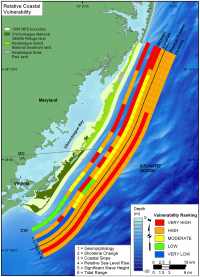

Map of Coastal
Vulnerability
  |
RESULTS
 |
| Figure 5. Relative Coastal Vulnerability for ASIS. Click on figure for larger image. |
The calculated CVI values for Assateague Island range from 14.61 to 32.66. The mean CVI value is 24.93; the mode and the median are 25.30. The standard deviation is 4.91. The 25th, 50th, and 75th percentiles are 20.5, 25.5 and 29.0, respectively.
Figure 5 shows a map of the CVI divided into ranges (low - very high) for Assateague Island National Seashore. CVI values were divided into low, moderate, high, and very high-vulnerability categories based on the quartile ranges and visual inspection of the data. CVI values below 20.5 are assigned to the low vulnerability category. Values from 20.6 to 25.5 are considered moderate vulnerability. High-vulnerability values lie between 25.6 and 29.0. CVI values above 29.0 are classified as very high vulnerability. Figure 6 shows a histogram of the
 |
| Figure 6. Percentage of ASIS shoreline in each CVI vulnerability category. Click on figure for larger image. |
percentage of ASIS shoreline in each vulnerability category. Nearly 60 km (37 miles) of shoreline is evaluated along the national seashore. Of this total, 30 percent of the mapped shoreline is classified as being at very high vulnerability due to future sea-level rise. Thirty percent is classified as high vulnerability, twenty-one percent as moderate vulnerability, and eighteen percent as low vulnerability.
|

|




